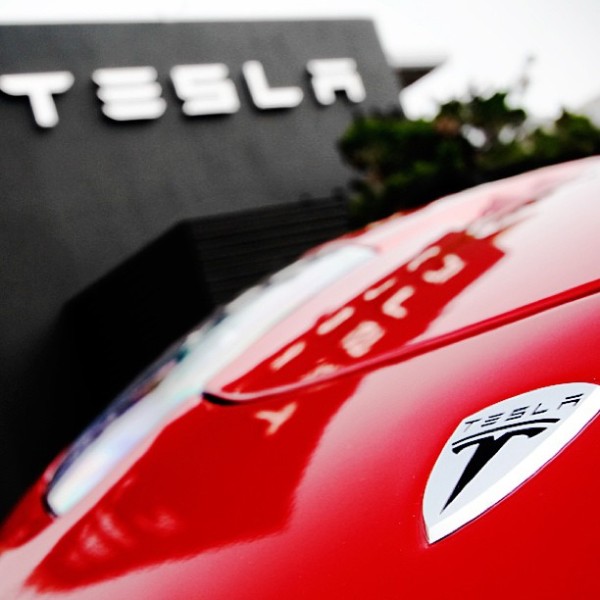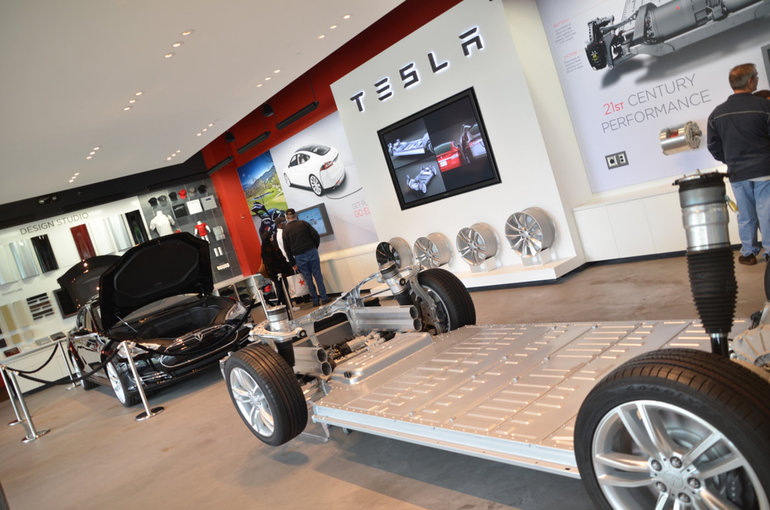News
The NJ mafia puts contract hit on Tesla


Elon Musk is always one step away from pushing the envelope further. Is calling New Jersey the mafia state enough of a wake up call?
Governor Chris Christie exemplifies modern politics clichés by turning around his previous decision legally working with Tesla Motors to follow suit with Texas and Arizona. Is there a pattern? Far from engaging in politics at Teslarati, we can’t help but wonder why those states known for their free markets ideals turned their back on the rhetoric? Where is competition and free market these days?
Does anybody remember freedom of choice?
Elon’s post rightfully reminds us of the disconnect between politicians and their constituents by saying: “the New Jersey Motor Vehicle Commission, composed of political appointees of the Governor, ended your right to purchase vehicles at a manufacturer store within the state” on his post. Governor Christie promised to put a vote to Tesla selling directly, but once the very big, and very powerful auto dealer lobby voiced their concerns, a backroom deal was cut, thus circumventing the legal process. Essentially, the auto dealer association pressures Chris Christie to force anyone buying a new vehicle through middlemen in New Jersey.
Essentially, Elon Musk accuses the Administration and the New Jersey Motor Vehicle Commission of: “going beyond their authority to implement the state’s laws at the behest of a special interest group looking to protect its monopoly at the expense of New Jersey consumers.”
Automotive Dealerships is a humongous lobby.
We’ll let you gauge how powerful the National Automotive Dealership Association is. Last year, there were 17,600 dealers of new cars and trucks in the US, yielding over $676 billion of sales, accounting for about 15 percent of all US retail activities. The automotive dealership is a substantial part of the country’s economy and its $86.8 million of dealership monies continuously spends $57 million funneled on state election across the country since 2003.
A few days back, we wrote about how the inevitable has to happen, bringing back our country to its foundation of freedom of choice. Dealerships don’t have the best reputation, and certainly very few people praise their services. Is it any wonder they push for an old, worn out self-serving business model? Tesla’s model is so modern, answers the needs of our current era and reflects a very real demand for freedom of choice. Simply put, dealerships do not offer the added services they once did, and are not able to change that quickly. Sounds familiar? Carmakers feel the same. Tesla Motors creeps under Detroit’s car manufacturers’ skin. They feel the inevitable, that change is a constant and you cannot turn around a big corporation instantly. Does that mean we don’t need car dealerships? Certainly not.
Tesla Motors is about now.
If we put everything into perspective, we find Tesla Motors answers our urgent need for elegant performance cars that run on an efficient energy means, electricity. Carmakers are left in the less enviable position of making petroleum derivative powered cars that pollute, smell bad and make awful noises. What truly isn’t fair is to expect these big carmaker and their dealerships to turn on a dime and start manufacturing batteries and electric motors. They are not tooled for this, and the investments would be gargantuan.
The Tesla stores frighten auto dealerships.
Why wouldn’t they be frightened by the Tesla stores, conveniently located inside malls, at the mercy of any onlooker? If you are relegated to the outskirts of the city, next to other car dealerships, knowing how people dread going to look for that new car, carefully maneuvering pushy salesmen, deciphering the unintelligible jargon and financing pitfalls, wouldn’t you fear Tesla? What do you do against a Tesla store that has a list of Model S drivers who will let you ride and sometimes drive their personal car? Know anyone who that with the internal combustion engine (ICE) drivers? Neither do we. But, why would you fight this marvelous system?
In the meantime, it’s hard not to feel sorry for politicians seeing constituents losing faith and car dealership lobbies facing better business models. Would you be frightened, or would you take the opportunity to change and adapt, once and for all?

Elon Musk
Elon Musk and Tesla AI Director share insights after empty driver seat Robotaxi rides
The executives’ unoccupied tests hint at the rapid progress of Tesla’s unsupervised Robotaxi efforts.

Tesla CEO Elon Musk and AI Director Ashok Elluswamy celebrated Christmas Eve by sharing personal experiences with Robotaxi vehicles that had no safety monitor or occupant in the driver’s seat. Musk described the system’s “perfect driving” around Austin, while Elluswamy posted video from the back seat, calling it “an amazing experience.”
The executives’ unoccupied tests hint at the rapid progress of Tesla’s unsupervised Robotaxi efforts.
Elon and Ashok’s firsthand Robotaxi insights
Prior to Musk and the Tesla AI Director’s posts, sightings of unmanned Teslas navigating public roads were widely shared on social media. One such vehicle was spotted in Austin, Texas, which Elon Musk acknowleged by stating that “Testing is underway with no occupants in the car.”
Based on his Christmas Eve post, Musk seemed to have tested an unmanned Tesla himself. “A Tesla with no safety monitor in the car and me sitting in the passenger seat took me all around Austin on Sunday with perfect driving,” Musk wrote in his post.
Elluswamy responded with a 2-minute video showing himself in the rear of an unmanned Tesla. The video featured the vehicle’s empty front seats, as well as its smooth handling through real-world traffic. He captioned his video with the words, “It’s an amazing experience!”
Towards Unsupervised operations
During an xAI Hackathon earlier this month, Elon Musk mentioned that Tesla owed be removing Safety Monitors from its Robotaxis in Austin in just three weeks. “Unsupervised is pretty much solved at this point. So there will be Tesla Robotaxis operating in Austin with no one in them. Not even anyone in the passenger seat in about three weeks,” he said. Musk echoed similar estimates at the 2025 Annual Shareholder Meeting and the Q3 2025 earnings call.
Considering the insights that were posted Musk and Elluswamy, it does appear that Tesla is working hard towards operating its Robotaxis with no safety monitors. This is quite impressive considering that the service was launched just earlier this year.
Elon Musk
Starlink passes 9 million active customers just weeks after hitting 8 million
The milestone highlights the accelerating growth of Starlink, which has now been adding over 20,000 new users per day.

SpaceX’s Starlink satellite internet service has continued its rapid global expansion, surpassing 9 million active customers just weeks after crossing the 8 million mark.
The milestone highlights the accelerating growth of Starlink, which has now been adding over 20,000 new users per day.
9 million customers
In a post on X, SpaceX stated that Starlink now serves over 9 million active users across 155 countries, territories, and markets. The company reached 8 million customers in early November, meaning it added roughly 1 million subscribers in under seven weeks, or about 21,275 new users on average per day.
“Starlink is connecting more than 9M active customers with high-speed internet across 155 countries, territories, and many other markets,” Starlink wrote in a post on its official X account. SpaceX President Gwynne Shotwell also celebrated the milestone on X. “A huge thank you to all of our customers and congrats to the Starlink team for such an incredible product,” she wrote.
That growth rate reflects both rising demand for broadband in underserved regions and Starlink’s expanding satellite constellation, which now includes more than 9,000 low-Earth-orbit satellites designed to deliver high-speed, low-latency internet worldwide.
Starlink’s momentum
Starlink’s momentum has been building up. SpaceX reported 4.6 million Starlink customers in December 2024, followed by 7 million by August 2025, and 8 million customers in November. Independent data also suggests Starlink usage is rising sharply, with Cloudflare reporting that global web traffic from Starlink users more than doubled in 2025, as noted in an Insider report.
Starlink’s momentum is increasingly tied to SpaceX’s broader financial outlook. Elon Musk has said the satellite network is “by far” the company’s largest revenue driver, and reports suggest SpaceX may be positioning itself for an initial public offering as soon as next year, with valuations estimated as high as $1.5 trillion. Musk has also suggested in the past that Starlink could have its own IPO in the future.
News
NVIDIA Director of Robotics: Tesla FSD v14 is the first AI to pass the “Physical Turing Test”
After testing FSD v14, Fan stated that his experience with FSD felt magical at first, but it soon started to feel like a routine.

NVIDIA Director of Robotics Jim Fan has praised Tesla’s Full Self-Driving (Supervised) v14 as the first AI to pass what he described as a “Physical Turing Test.”
After testing FSD v14, Fan stated that his experience with FSD felt magical at first, but it soon started to feel like a routine. And just like smartphones today, removing it now would “actively hurt.”
Jim Fan’s hands-on FSD v14 impressions
Fan, a leading researcher in embodied AI who is currently solving Physical AI at NVIDIA and spearheading the company’s Project GR00T initiative, noted that he actually was late to the Tesla game. He was, however, one of the first to try out FSD v14.
“I was very late to own a Tesla but among the earliest to try out FSD v14. It’s perhaps the first time I experience an AI that passes the Physical Turing Test: after a long day at work, you press a button, lay back, and couldn’t tell if a neural net or a human drove you home,” Fan wrote in a post on X.
Fan added: “Despite knowing exactly how robot learning works, I still find it magical watching the steering wheel turn by itself. First it feels surreal, next it becomes routine. Then, like the smartphone, taking it away actively hurts. This is how humanity gets rewired and glued to god-like technologies.”
The Physical Turing Test
The original Turing Test was conceived by Alan Turing in 1950, and it was aimed at determining if a machine could exhibit behavior that is equivalent to or indistinguishable from a human. By focusing on text-based conversations, the original Turing Test set a high bar for natural language processing and machine learning.
This test has been passed by today’s large language models. However, the capability to converse in a humanlike manner is a completely different challenge from performing real-world problem-solving or physical interactions. Thus, Fan introduced the Physical Turing Test, which challenges AI systems to demonstrate intelligence through physical actions.
Based on Fan’s comments, Tesla has demonstrated these intelligent physical actions with FSD v14. Elon Musk agreed with the NVIDIA executive, stating in a post on X that with FSD v14, “you can sense the sentience maturing.” Musk also praised Tesla AI, calling it the best “real-world AI” today.








